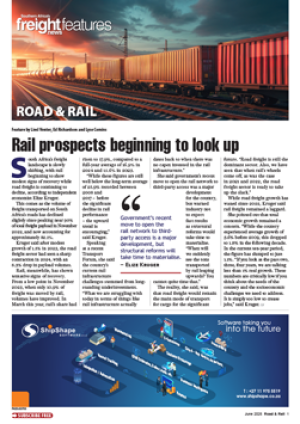As South Africa battles a deepening logistics crisis and attempts to revive its struggling railway sector, growing concerns are being raised over the transparencyand accountability of the reform process. These concerns centre around whether the current path will revitalise the country’s critical national asset or inadvertently undermine it.According to Mesela Nhlapo, CEO of the African Rail Industry Association (Aria), the current overhaul of the railways is not necessarily in the best interest of the country. “I am not convinced that the approach being taken is what is best for South Africa,” she said. “Transnet will be restricted in what it can and cannot do, while we are seeing the system increasingly being run by the National Logistics Crisis Committee (NLCC). That is worrying.” Lack of transparencyNhlapo highlights a critical lack of transparency in the process. “The process was far from transparent, with little clarity on who sat on the committee or how decisions were being made,” she said. “Business is effectively running the system now, but we have to ask the question: Who is holding the crisis committee accountable?” Speaking to Freight News, Nhlapo said that with decades of underinvestment in rail, and infrastructure now at a crisis point, the restructuring of the country’s railways was non-negotiable. However, she stresses that the nature of this reform is paramount.“In 2018, Transnet Freight Rail (TFR) was moving around 228 million tonnes per year, but we’ve seen volumes in steady decline since then,” Nhlapo stated. Aria’s stance is unequivocal: a successful Transnet equates to a successful railway industry. The goal of reform should be to empower and capacitate Transnet to return to and surpass its previous performance levels. “The move to reform the railways was originally intended to allow private sector participation on the network, not to replace Transnet, which is what now seems to be transpiring. If TFR is capable of handling 228 million tonnes per annum, then reform must take the shape of the private sector supplementing and complementing what TFR does.” Nhlapo said Transnet remained the backbone of South Africa’s railway sector because of its developmental mandate. “And that must not be abandoned,” she asserted. “The goal is for new private operators to supplement and complement Transnet’s capabilities.” Primary objectiveThis partnership is essential. “The primary objective of this entire process must be to get more freight off our roads and increase the total tonnage moved on rail, thereby enhancing network efficiency and driving national economic grow th.” The roots of South A f r ica’s rail crisis can be traced back to policy decisions made in the 1980s when a shift in focus from rail to road began. “This crisis didn’t start yesterday,” said Nhlapo. “The decision to prioritise road over rail marked the beginning of decades of underinvestment, the effects of which we are still dealing with today. Ongoing equipment failures and widespread theft have, for the most part, crippled the network.” Continuous investment in rail infrastructure is essential, with both the public and private sectors playing a role. “Crucially, as we invite this investment, the localisation and designation policy must be consistently applied to both public and private sector operators. This is non-negotiable for sustainable and equitable development,” she said.Nhlapo also warned that private sector involvement must not result in simply replacing one monopoly with another. “The aim is to foster a competitive, dynamic market that benefits the entire rail ecosystem and, ultimately, the South African economy.Broader strategy“Furthermore, the revitalisation of our railways must be part of a broader, intentional strategy for the reindustrialisation of the country. This strategic approach will ensure that economic growth is robust and, critically, that inclusive growth is achieved, creating jobs and opportunities for all South A fr icans.”Nhlapo emphasised that economic recovery depended on an efficient and integrated transport system. “Business can only operate effectively if we have a logistics network that works,” she said. This requires a fundamental shift in perspective. “The concept of multimodal transport is key. We must stop positioning rail and road as competitors. Instead, we need a system that is efficient, affordable and complementary.”LV
Rail reform must strengthen not sideline Transnet for economic recovery
26 Jun 2025 - by Liesl Venter
0 Comments
Road & Rail 27 June 2025

26 Jun 2025
26 Jun 2025
26 Jun 2025
26 Jun 2025
26 Jun 2025
26 Jun 2025
26 Jun 2025
26 Jun 2025
26 Jun 2025
26 Jun 2025
26 Jun 2025
Border Beat
25 Jun 2025
17 Jun 2025
Poll
Featured Jobs
New
